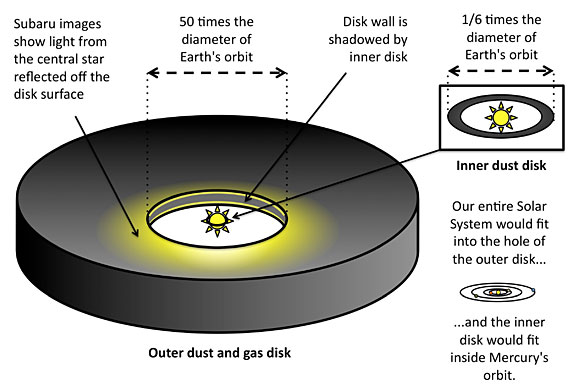Direct Images of Disks Unravel Mystery of Planet Formation

Figure 1: Near-infrared (1.6 micron) images of AB Aur. The top panels compare images taken by HiCIAO and CIAO. Both images have a field of view of 7.5″ by 7.5″. Top left: Image taken by HiCIAO using a coronagraphic occulting mask with a 0.3″ diameter. Top right: Image taken by CIAO using a software mask with a 1.7″ diameter. The bottom panels show close-up views of the inner part of AB Aur’s disk. Both images have a field of view of 2.0″ by 2.0″. Bottom left: Image has a coronagraphic occulting mask with a 0.3″ diameter. Bottom right: Image includes labels of its prominent features. The central position (0, 0) refers to the location of the star. Ellipsoids in dashed lines show the outer and inner rings. The solid ellipsoid indicates the wide gap between the rings. The “+” shows where the star is. The filled circle is the center of the outer ring. For this object, 1″ (one arc second) corresponds to 144 AU in real scale (144 times the distance between Earth and Sun).
The fruits of the SEEDS (Strategic Explorations of Exoplanets and Disks with Subaru) project, led by Motohide Tamura of NAOJ (National Astronomical Observatory of Japan), are accumulating. Composed of over 100 scientists and 25 institutions, the international consortium of researchers supporting the project has announced another set of stunning findings obtained with the recently commissioned Subaru Telescope instrument HiCIAO (High Contrast Instrument for the Subaru Next Generation Adaptive Optics), an upgraded version of its predecessor CIAO (Coronagraphic Imager with Adaptive Optics).
Their initial announcement of a significant discovery came in December 2009: an exoplanet candidate around a Sun-like star. Now they announce another remarkable discovery: The telescope has directly and sharply imaged two young stars that reveal how planets may have formed from their disks. No other telescopes, whether ground-based or in space, have ever penetrated so close to central stars, showing the details of their disks.
One of the images is of the disk of the very young star AB Aur in the constellation Auriga. The star is only about one million years old and is surrounded by its protoplanetary disk, a structure of gas and dust from which planets are likely to form. The image displays high spatial resolution as well as high contrast within the disk near its central star; it reveals, for the first time, the fine structures of a disk orbiting closer to its star than Neptune’s distance from the Sun in our solar system. AB Aur’s disk has double rings that are tilted from the equatorial plane; a void of material between the rings; and a center that does not coincide with the position of the star. These irregularities suggest that at least one giant planet is affecting the features of the disk.


Figure 2: High-contrast near-infrared imaging of LkCa 15 disk.
Top: Image taken by HiCIAO. The central star is hidden by the dark brown area toward the center. The inner edge of the outer disk is visible. The white feature below the blocked out area is part of the disk illuminated by the central star. The opposite side of the disk is not readily visible. There is a gap between the inner boundary of the disk and the star, at a distance of about 50 AU (Astronomical Unit, the distance between the Earth and the Sun, about 150 million kilometers or 94 million miles. The middle figure is a sketch of the LkCa 15 star and its disk system. The yellow-colored region corresponds to the features in the HiCIAO image. Bottom: Neptune’s orbit in the Solar System as a scale comparison.
The other image from the project is that of another young star, LkCa 15, which is several million years old. Although previous works speculated that there was a gap in its disk, this is the first direct imaging of a central gap in the disk. The lack of material in the vicinity of the central star implies that a giant planet is sweeping up the disk’s leftover materials that the central star did not swallow.
Overall, these first two direct images of the detailed structure of the protoplanetary disks provide strong evidence for planet formation within a system on the scale of our solar system. The influence of heavy planets is likely to have produced the irregular features of the disks. The SEEDS project will continue for five years, allowing astronomers to search the universe for exoplanets and their protoplanetary disks, in an ongoing quest to decipher how planetary systems form. Recent and future findings from the project may eventually contribute to our understanding of how Earth-like habitable zones develop.
# # #
The article with results for AB Aur has been accepted by the Astrophysical Journal for publication in 2011. The results for LkCa 15 were previously published in the Astrophysical Journal (Thalmann et al. 2010, Ap.J., 718, 87).
For images, figures, and a more detailed discussion of the project and its findings, please go to the longer article posted in the Science Results section of the Subaru Telescope’s website: http://www.SubaruTelescope.org
Media Contacts:
Suzanne G. Frayser
+1 808-934-5022
frayser@naoj.org
Saeko S. Hayashi
+1 808-934-5947
saeko@naoj.org
Science Contacts:
Jun Hashimoto
+81 90-5083-7264
jun.hashimoto@nao.ac.jp
Motohide Tamura
+81 422-34-3527; cell: +81 90-7198-8360
motohide.tamura@nao.ac.jp
Text & Images:
http://www.naoj.org/Press_folder/2011/0217/index.html









